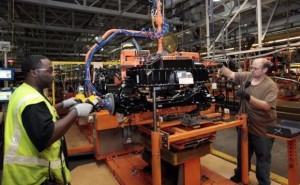
Credit: Reuters
(Reuters) – U.S. factory activity accelerated for a second straight month in March and auto sales surged, the latest signs the economy was regaining footing after a brutal winter.
Unusually cold and snowy weather chilled activity early in the year and signs of a thaw have raised hopes of a strong bounce back in economic growth in the second quarter.
“Winter is over. The economy is looking more positive,” said Chris Rupkey, chief financial economist at Bank of Tokyo-Mitsubishi UFJ in New York.
The Institute for Supply Management said on Tuesday its index of national factory activity rose to 53.7 last month from 53.2 in February. A production sub-index posted its biggest increase since the recession ended.
Any reading above 50 indicates expansion.
Separately, automakers reported that U.S. sales jumped 5.7 percent in March from a year ago to a 16.4 million vehicle annual pace, blowing past expectations for a rise to only a 15.8 million unit rate.
“We’re optimistic that momentum will spring us into April,” said Bill Fay, general manager for Toyota brand U.S. sales.
Stocks on Wall Street pushed higher on the reports, with the Standard & Poor’s 500 index closing at a record high. Prices for U.S. Treasury debt fell and the dollar was little changed against a basket of currencies.
CUSTOMER INVENTORIES DOWN
A softening in an employment gauge was one of the few sour notes in the otherwise upbeat ISM factory report.
The forward-looking new orders index rose, there was a big gain in order backlogs, and 14 of the 18 manufacturing industries reported growth.
“The broad-based nature of the gains among industries underscores the extent of the rebound,” said Millan Mulraine, deputy chief economist at TD Securities in New York.
Even as the sector begins to break out of its cold spell, activity remains weaker than during the second half of last year. Warehouses are bulging with goods, leaving businesses with little incentive to place large orders with manufacturers.
The ISM survey found a sharp drop in customers’ inventories, though manufacturers’ inventories were unchanged.
A desire to reduce inventory and the harsh weather are expected to hold the economy to an annualized growth pace below 2 percent in the first quarter. That would be a step back from the fourth quarter’s 2.6 percent rate.
While manufacturing appears to be shaking off winter’s chill, construction continued to be held back in February.
The Commerce Department said construction spending edged up 0.1 percent after slipping 0.2 percent in January, hurt by the biggest fall in private homebuilding since July.
But a surge in spending on nonresidential construction, such as factories and power plants, lifted overall private outlays to their highest level since December 2008.
“Given housing’s recent disappointing numbers, this sector’s cyclical turnaround comes at a good time,” said Stephanie Karol, an economist at IHS Global Insight in Lexington, Massachusetts.
Public construction spending posted a small gain, with a jump in federal outlays offsetting a fall in state and local government spending.








